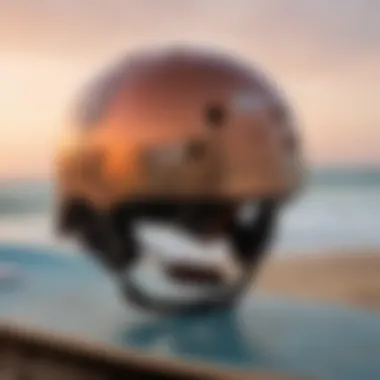Choosing the Best Skateboarding Helmets: Essential Tips


Intro
Choosing the right helmet for skateboarding goes beyond just aesthetics; it is about safeguarding yourself while enjoying the thrill of the ride. With a myriad of options available in the market, it can feel like trying to find a needle in a haystack. Every skateboarder, whether a seasoned pro or a novice, is faced with a multitude of choices regarding safety features, fit, style, and even brand preference.
Skateboarding is not just a sport; it’s a culture woven into the fabric of creativity and adrenaline. Helmets play a pivotal role in this lifestyle, offering much-needed protection and making a fashion statement all at once. As we explore the intricacies of selecting the right helmet, we will dive into critical aspects such as safety certifications, materials used, comfort, and maintenance. Additionally, understanding how personal preferences can influence your helmet selection will offer you a well-rounded view of this essential gear.
"Safety isn't just a gadget, it's a state of mind." - Anonymous
Keep your helmets in tip-top shape. The helmet's efficacy isn't only reliant on the model you chose but also on its maintenance and fit. This guide will walk you through the essential elements needed to make an informed decision, ensuring that you're not just riding in style, but also prioritizing your safety above all. Let's embark on this journey together, elevating both your knowledge and your ride.
Understanding the Importance of Helmets
When it comes to skateboarding, safety isn't just a guideline; it’s a necessity. Helmets serve as the armor for those who dare to ride along skateparks, streets, and ramps. Investing in a good helmet can mean the difference between a minor mishap and a serious injury. Not only do they protect your noggin from unexpected falls, but they also boost your confidence, allowing you to push the limits of your skills with a bit more reassurance.
The truth is, helmets have evolved over the years. What was once seen by some as a cumbersome piece of equipment is now recognized as an essential part of skateboarding gear. From stylish designs to advanced materials, the industry's offered choices appeal to the aesthetic sensibilities of skaters while also prioritizing safety.
The Role of Helmets in Skateboarding Safety
Helmets are paramount in mitigating the impact of crashes. The human head is vulnerable, and even a small fall can lead to potential brain injuries. A helmet acts as a cushion, absorbing shocks and distributing the force of impacts. High-quality helmets are designed specifically for skateboarding, adhering to specific guidelines that keep riders safe.
It's crucial to recognize that not all helmets are created equal. Some are tailored for specific types of skating, such as street skating, while others are better suited for vert and bowl situations. Some helmets even come with visors for added protection against sunlight or debris, catering to the varying needs of skateboarders.
"Wearing a helmet might seem like a hassle, but it’s a small price to pay for the peace of mind it brings while cruising at high speeds."
Statistics on Skateboarding Injuries
Notably, the statistics surrounding skateboarding injuries emphasize the importance of helmets. According to research, about 50% of skateboard-related injuries involve the head. These figures underscore the urgency of wearing helmets during skateboarding activities.
Let’s explore some numbers:
- Over 150,000 injuries related to skateboarding are reported in the U.S. annually.
- Head injuries make up roughly 20% of these incidents.
While skaters often endure scrapes and bruises, the potential for serious concussion or traumatic brain injury is real. Wearing a helmet doesn't just serve as a safeguard, but also as a statement of responsibility toward oneself and fellow skaters. Understanding these grim figures is essential in shaping attitudes toward helmet use, elevating them from mere fashion accessories to vital safety equipment.
Types of Skateboarding Helmets
When it comes to skateboarding, choosing the right helmet is as critical as selecting the board itself. The right type of helmet not only safeguards your noggin but can also significantly enhance your skating experience. Skaters need to be aware of the various styles and designs available, each tailored for specific activities and conditions. Below, we explore various helmet types, discussing their individual characteristics, benefits, and suitable usage scenarios.
Full-Face Helmets
Full-face helmets combine comprehensive protection with an ergonomic design, making them a favored choice among aggressive skaters. These helmets offer coverage from the chin to the top of the head. This additional protection comes in handy, especially in extreme sports environments where falls are more common. The snug fit ensures that the helmet stays securely in place during high-speed runs or tricks.
Pros of full-face helmets include:
- Maximum Protection: The design absorbs impact, reducing the risk of facial injuries.
- Enhanced Stability: They stay put, which is crucial for performance-oriented riders.
- Style Factor: Many models sport a sleek, aggressive look that appeals to serious skaters.
However, the downside is that they can feel restrictive, especially for those who prioritize comfort and airflow during less intensive sessions. Some may find it a bit cumbersome to wear over extended periods. If you're aiming to push the limits in your skating, a full-face helmet could be worth considering—but just be mindful of comfort versus extreme protection.
Half-Pipe Helmets
The half-pipe helmet focuses on flexibility and breathability, ideal for skaters who frequently grind on ramps or trick in skate parks. Unlike the full-face option, half-pipe helmets usually cover just the head and are lightweight. This lighter design helps prevent overheating during rigorous skate sessions while still offering essential coverage.
Benefits include:
- Comfort: Lighter materials and minimalistic design often make for a more comfortable fit.
- Improved Ventilation: Many models feature vents that allow for increased airflow, keeping you cool.
- Versatility: Suitable for various types of skating beyond just half-pipes, including street and bowl skating.
It's worth noting that while they do provide decent protection for the top and back of the head, they lack the facial coverage that some skaters may prefer, especially when attempting more risky maneuvers. If you're more into flowing through the park or showing off tricks, a half-pipe helmet could very likely fit the bill.
Bicycle Helmets Versus Skateboarding Helmets
The chatter about whether a bicycle helmet can cut it for skateboarding is one that both newbies and veterans often engage in. The core difference lies in the design philosophy and how well they absorb impacts. Bicycle helmets are designed to cover the top of the head and are often constructed with lighter materials, ideal for consistent, straightforward impacts on bikes. Skateboarding helmets, on the other hand, are specifically designed to protect against the types of impacts commonly experienced when skating.
Key differences include:
- Impact Protection: Skateboard helmets often have a thicker padding and are tested for multi-directional impacts.
- Coverage: Skateboarding helmets provide a more rounded coverage that is better suited for the falls typical to skateboarding.
- Ventilation: Bicycle helmets usually have more vents, which can be beneficial in terms of airflow but could sacrifice some protective quality in a crash.
Key Safety Standards and Certifications
When it comes to choosing the right helmet for skateboarding, understanding the key safety standards and certifications is non-negotiable. These standards not only ensure adequate protection but also provide peace of mind for both riders and their guardians. Safety isn't just a nice-to-have; it's a must-have. Knowing what to look for can save lives—and that’s not an understatement.


Understanding the CPSC Standard
The Consumer Product Safety Commission (CPSC) sets the gold standard for helmet safety in the United States. Helmets that meet the CPSC standards are tested rigorously to ensure they provide sufficient protection against impacts. Simply put, if a helmet is marked with a CPSC sticker, it means that it has passed critical safety tests.
A few important points about the CPSC standard include:
- Impact Resistance: The helmet must absorb impacts to prevent head injuries during a fall or collision. Manufacturers have to prove that their helmets can withstand multiple types of impacts.
- Retention System: The straps must stay in place even under stress, ensuring the helmet remains secure during use.
- Manufacturing Guidelines: Helmets must be made from materials that are resilient and suitable for the sport, keeping safety as the core priority.
Why CPSC Matters
"A helmet is only as good as the standards it meets. Without them, you might as well be wearing a colander." Ensuring that a helmet adheres to the CPSC guidelines should be your primary concern. It's a protective layer between the ground and your skull, especially when you take that epic leap off a skateboard ramp.
Other Notable Certifications
While the CPSC standard is highly regarded, several other notable certifications can add layers to your helmet safety assessments:
- ASTM F1492: This certification signifies that the helmet meets specific standards for use in skateboard-specific activities. It includes tests related to shell penetration and impact protection.
- EN 1078: This is a European standard for safety helmets for cyclists and skateboarders. It's similar to the CPSC standard but has different test methods and performance criteria. If you're in Europe or buying from a European brand, this is crucial.
- Snell Memorial Foundation: This independent organization focuses on performance standards for helmets across various sports. Helmets with a Snell certification are known for their rigorous safety testing, often exceeding basic CPSC or ASTM requirements.
- ISO 3873: International Organization for Standardization also sets guidelines for the characteristics of helmets used in roller sports, which include skateboarding. Meeting ISO standards means the helmet has been tested under various conditions for safety.
Selecting a helmet that meets these standards is one of the most important steps in ensuring your safety. With so many options out there, knowledge of these certifications can give you the upper hand, making sure you’re buying a reliable product that won’t let you down.
Being well-informed about the safety specifications and relevant certifications can make all the difference when it’s time to hit the skatepark. A good helmet is your best friend on the road to skating excellence.
Materials Used in Helmet Construction
Choosing the right materials for a skateboard helmet is pivotal. The materials not only determine the helmet's ability to absorb impact but also influence its overall comfort and durability. A helmet’s construction plays a significant role in protecting the wearer from injuries. In the world of skateboarding, where falls and tumbles are part and parcel of the experience, understanding the materials used can empower skaters to make informed decisions that align safety with their personal preferences.
Expanded Polystyrene (EPS)
Expanded Polystyrene (EPS) is practically the backbone of most helmets on the market. This lightweight foam material is notable for its energy-absorbing properties, which help mitigate impacts during a fall. EPS can compress when it encounters force, absorbing some of that energy to protect the head.
- Benefits of EPS:
- Lightweight: Makes the helmet easy to wear for extended periods.
- Impact resistance: Efficiently absorbs energy from hits, reducing the risk of severe injuries.
The downside? Over time, EPS may weaken after several impacts, reducing its efficiency. Hence, keeping an eye on the integrity of the helmet is important.
Polycarbonate Shells
On the exterior, many helmets are fitted with polycarbonate shells. This durable plastic is tough enough to take on the wear and tear associated with skateboarding, keeping the head shielded from sharp objects and scrapes. The role of these shells cannot be understated; they form the first line of defense in an accident.
- Advantages of Polycarbonate:
- Durability: Stands resistant against dents and scratches.
- Lightweight: Doesn’t add unnecessary weight, ensuring comfort and ease of movement.
While polycarbonate is reliable, it can also flex under high impact, which is why a combination of materials is often preferred in construction.
Impact-Resistant Materials
Increasingly, helmet manufacturers are incorporating advanced materials designed to enhance safety, such as high-density polyethylene. These impact-resistant materials work alongside EPS and polycarbonate, providing additional layers of defense against significant shocks. They exhibit exceptional functionality, increasing the overall protective capability of the helmet.
Some key features of these materials are:
- Multi-directional impact resistance: Helps reduce rotational forces during crashes, which can often lead to concussions.
- Temperature durability: Maintains its properties even on hot summer days when skaters are out for hours on end.
Integrating impact-resistant materials in helmets is becoming more common, signaling a positive trend toward better safety standards in skateboarding.
Comfort and Fit
When it comes to skateboarding, having a helmet that feels right can make all the difference in how confident you feel while riding. Comfort and fit are pivotal. If a helmet is too tight, it can cause headaches and distractions. A loose helmet, on the other hand, increases the risk of injury. Finding that sweet spot is not just a matter of preference; it’s a matter of safety.
Finding the Right Size
Determining the right size of a helmet is the first step. Each brand has its sizing chart, and this is where following the metrics is crucial. Place a measuring tape around the largest part of your head, usually just above your ears. Jot down the measurement, and consult the sizing guide provided by the manufacturer. Helmets often come in small, medium, large, and so on, but these can vary by brand. Don’t just pick a size based on what you think fits best; actually measure it.
- Use a soft measuring tape for accuracy.
- Check multiple brands since sizes may differ.
- Remember that fit might change with age, hair length, or style.
Always try the helmet on before making a purchase, if possible. It should sit level on your head and snugly without causing discomfort.
Adjustable Features for a Customized Fit


Many modern helmets come equipped with adjustable features that help with fit. Look for adjustable straps, removable padding, or even built-in systems that allow you to customize based on your head shape. A helmet that conforms to your unique anatomy provides better protection.
- Dial Fit System: Some helmets have a dial on the back that can tighten or loosen the fit as needed. This can be particularly useful if you're wearing headgear or hair accessories.
- Padding: Removable pads can allow you to adjust the interior, making it easier to get that perfect fit.
Being able to tweak the fit can be not just comfortable but also crucial for safety during those daring skate tricks.
Ventilation Considerations
Skateboarding can be a physically intensive activity, especially during hot days or prolonged sessions. Therefore, ventilation in helmets is key. A well-ventilated helmet reduces sweat build-up and helps maintain a comfortable temperature inside. When shopping for helmets, look for models with strategically placed vents.
- Airflow through Vents: Some helmets have large vents that allow fresh air in, keeping the interior cooler.
- Moisture-Wicking Liners: This feature is important for absorbing sweat, keeping your skin comfortable.
Having good ventilation makes the difference between a helmet you can wear through a long session and one that feels like a sweaty burden.
"The fit of your helmet should inspire confidence in your ride. The right comfort can elevate your skating experience, ensuring that safety and style coexist harmoniously."
In summary, prioritizing comfort and fit enhances not only your skateboarding experience but also your safety. Don’t underestimate how these elements interplay – it can be the determining factor in your ride.
Popular Helmet Brands in Skateboarding
When it comes to choosing a helmet for skateboarding, the brand you select can significantly influence both safety and style. Popular helmet brands in skateboarding not only have a reputation for quality but also offer unique features tailored to the needs of skaters. Understanding these brands can help you make an informed decision, ensuring your safety while showing off your personal flair.
Overview of Leading Brands
Several brands stand out in the crowded arena of skating helmets. Each has its own unique touch. Some of the notable names include:
- Bell: Known for its commitment to safety, Bell helmets often feature innovative technology and sturdy designs. Their helmets are both functional and stylish, catering to the tastes of modern skaters.
- Pro-Tec: A pioneer in the helmet industry, Pro-Tec offers a variety of models that provide adequate protection without compromising comfort. Their classic styles have become a staple among skateboarders.
- Troy Lee Designs: This brand is favored by many professional skaters. With a strong focus on aesthetics as well as protection, Troy Lee designs helmets that are as much about personal expression as they are about safety.
- Triple Eight: Triple Eight has carved out a niche by offering multi-sport helmets. Their products are known for being versatile, catering not just to skateboarders but also to BMX riders and rollerbladers.
- SPY: While perhaps better known for goggles and eyewear, SPY also produces helmets that blend style with safety. This brand often appeals to those who wish to stand out on the street.
With these brands, you have a range of options that balance quality and design.
Brand Comparison: Features and Prices
When comparing brands, it’s crucial to look at various factors—features, price range, and personal fit. Here’s a rundown of what to consider:
- Safety Features: Helmets from Bell and Pro-Tec come with reinforced padding and advanced impact absorption technology which can be a game-changer in preventing injuries.
- Comfort: Brands like Triple Eight and Troy Lee Designs offer adjustable features and various sizes that cater to different head shapes. This is key for long skate sessions.
- Design Options: If style is high on your priority list, SPY helmets stand out for their vibrant colors and customizable designs. Pro-Tec also offers a variety of graphics to choose from.
- Pricing: Prices can range significantly. Pro-Tec helmets might start around $40, while high-end models from Troy Lee Designs could go as high as $200. It’s essential to balance your budget with the quality and features that matter to you.
"The right helmet is not just a piece of gear; it’s a vital part of a skateboarder’s arsenal, protecting both body and style."
Links for Further Reading
Choosing the right helmet goes beyond just safety; it merges functionality with personal expression in one sleek, protective package.
Style and Aesthetic Considerations
Choosing a skateboard helmet is not just about safety; style also plays a pivotal role in the decision-making process. The skateboard culture is deeply rooted in self-expression, and helmets are no exception. A well-chosen helmet can reflect personal identity and enhance the overall skateboarding experience. When riders are pleased with the look of their gear, they often feel more confident on their boards and more willing to push their limits.
Beyond personal expression, the aesthetic attributes of a helmet can also influence social perceptions. Whether it’s a bold color, unique graphics, or a sleek silhouette, the right design can help a skateboarder stand out in a crowd. This desire to customize doesn’t just apply to experienced skaters; it reaches out to beginners too, who often admire their favorite riders and want to emulate their style.
Factors to consider when looking into style and aesthetic aspects include:
- Color Schemes: Bright colors can convey energy and excitement, while muted tones might suggest a more classic or understated approach.
- Graphic Designs: Helmets often feature artwork or logos that resonate with the wearer, representing a team, brand, or personal artwork.
- Shape and Fit: Some styles lend themselves better to specific head shapes, which can affect both comfort and appearance.
Ultimately, while the primary purpose of a helmet is protection, equally essential is how it aligns with one’s own style and how it fits into the broader culture of skateboarding.
Design Trends in Skateboarding Helmets
The design landscape of skateboard helmets is constantly evolving, mirroring trends in fashion and design at large. Currently, crucial trends shaping the market include:
- Minimalist Designs: Many brands are leaning towards clean lines and simple color palettes, appealing to riders who favor understated elegance. These designs often feature soft matte finishes that redefine traditional glossy looks.
- Retro Aesthetics: Nostalgia has made a comeback in many areas of design, and helmets are no exception. Throwback styles, reminiscent of the 70s and 80s, showcase bold colors and distinct shapes, allowing skaters to channel their inner vintage vibe.
- Innovative Graphics: As brands compete for attention, unique graphic designs have become a key selling point. Helmets adorned with artistic prints, graffiti-style art, or even customizable inserts are popular among younger skaters wanting something that sets them apart.
"A helmet that looks good can increase the likelihood of a skater actually wearing it, thereby boosting safety."
- Functional Design Features: More than just a fashion statement, current design trends involve creating helmets that serve dual purposes. For example, some helmets incorporate storage compartments or removable visors, blending style and practicality seamlessly.
Customizable Helmet Options
Customization has stamped its mark on the skateboard helmet market, offering skaters the chance to tailor their lids to suit their individual tastes. This trend is a win-win, enhancing both aesthetic appeal and user engagement. Options include:


- Interchangeable Pads and Covers: Some helmets allow users to swap out internal padding and external covers, making it easy to refresh the helmet’s look or improve comfort.
- Vinyl Stickers and Decals: Personalizing a helmet has never been simpler thanks to easily applied stickers. Riders can create a unique identity through vivid imagery that aligns with their personal story.
- Custom Paint Jobs: For those seeking an extraordinary look, opting for custom paint may be the best route. Skilled artists can turn an average-looking helmet into a canvas of expression.
- Color Choices: Many brands now offer a palette of colors and finishes for their helmets. Riders can choose to go with classic blacks and whites or daring neon shades that turn heads at the skate park.
By selecting customizable options, skaters not only get gear that fits well and protects them but also helps them express their individuality while riding. The opportunities for personalization are vast and invite creativity while promoting a sense of ownership over one’s gear.
Maintenance and Care for Helmets
Taking care of your helmet goes beyond just aesthetics; it's about ensuring safety and longevity. A well-maintained helmet can save you from compromising its protective qualities over time. These protective headgear are designed to absorb impacts and mitigate risks while skating, but they require regular upkeep to perform effectively. Understanding how to maintain your helmet not only prolongs its life span but also enhances your overall safety as you take to the skatepark.
Cleaning Techniques for Longevity
One of the most common mistakes riders make is neglecting to clean their helmets. A helmet can gather dust, sweat, and other gunk over time, which not only looks bad but can also degrade the materials used in construction.
- To clean your helmet, you should first remove any removable padding and liners. Most helmets come with detachable pieces that can often be washed separately. Check your helmet's instructions for specifics.
- Use a mild soap and warm water solution. Avoid harsh chemicals as they could compromise the materials. Gently wipe down the exterior and interior using a soft cloth.
- For stubborn stains, you may need to use a textured cloth but be gentle. Do not use abrasive cleaners or scrub pads, as they can scratch the surface.
- Rinse with water and let everything dry completely before reassembling. Humidity can play havoc on materials if they stay wet for too long.
Regularly cleaning your helmet helps in maintaining its integrity and ensures you avoid any unpleasant odors.
When to Replace Your Helmet
Knowing when to replace your helmet is just as vital as maintaining it. The general rule of thumb is that a helmet has a lifespan—typically, it should be replaced every three to five years, even if it has not been involved in an accident. Material degradation is a slow process often unnoticeable until it’s too late.
- After an impact: If your helmet has taken a hit, it’s crucial to replace it. Even if you don't notice visible damage, the impact can compromise its protective capabilities.
- Visible deterioration: Cracks, dents, or any unusual wear and tear are signs that it’s time for a replacement. Pay special attention to the shell and the foam inside.
- Fit issues: As you grow or change your headgear preference, your helmet’s fit may alter. A loose helmet is ineffective when it comes to protection.
- Safety certifications: Ensure your helmet still meets relevant safety standards. Sometimes, as new standards evolve, older helmets may no longer comply.
"Your helmet might just be a bunch of hard plastic and foam, but when it comes to protecting that noggin, it's priceless."
Being vigilant with both maintenance and knowing when to replace will keep you safe as you carve the ramps and streets. A piece of advice? Treat your helmet like your most prized possession—it deserves the care.
The Cultural Impact of Helmets in Skateboarding
The discussion surrounding helmets in skateboarding extends well beyond mere safety considerations. Helmets have increasingly become symbolic within the skateboarding community, epitomizing not just protection but also a shifting perception towards responsible riding. As skate culture evolves, the helmet’s role morphs into one that encapsulates both safety and style, reflective of broader shifts in societal attitudes toward risk and personal responsibility.
Helmets and the Shift in Skateboarding Perception
Once upon a time, wearing a helmet while skateboarding could have been perceived as a sign of caution or even weakness. Many skateboarders, especially the younger crowd, wore their willingness to embrace danger as a badge of honor. However, in recent years, this perception has immensely changed.
Today, helmets symbolize a new wave of understanding regarding safety. They are no longer mere afterthoughts, but rather essential components of streetwear that also represents enhanced awareness among riders. As public awareness around injuries has grown, so has the industry’s commitment to producing innovative designs that don’t cramp style.
This shift can be attributed to several factors. First, social media plays a crucial role in amplifying the message that protective gear is cool. Instagram and TikTok show skateboarders performing jaw-dropping tricks while rocking stylish helmets, making the gear desirable rather than a form of compromise. Nowadays, you’ll see more and more skaters posting their helmet selfies, turning protective gear into a fashion statement. This cultural adjustment encourages skaters of all ages to adopt a more responsible mindset without sacrificing personal style.
Some might think it silly, but the visual representation of helmets in today’s skate culture indeed impacts choice. When skateboarders like Lizzie Armanto and Nyjah Huston wear helmets, it sends a powerful statement - safety is paramount, but style is also integral to one’s identity as a skater.
Influences of Professional Skateboarders
Professional skateboarders represent a significant influence on the culture surrounding helmets. Their visibility and authority in the sport encourage young skaters to follow suit, including donning protective gear. Consequently, it is crucial to examine how these pros have propelled the evolution of helmet acceptance.
Take, for instance, Tony Hawk. Not just an icon for his skating prowess, but also a pioneer who promoted helmet use through public service announcements and sponsored events. His initiatives and partnerships with helmet brands were instrumental in changing the narrative around safety gear. Hawk showed that it doesn’t have to be all about rebellion and risk-taking, but can also include caution and responsibility.
In addition, the representation of female skateboarders has catalyzed a cultural shift as well. Women like Leticia Bufoni and Aori Nishimura advocate for protection on and off the board. They’ve helped solidify helmets as standard gear in the female skateboarding community, further dissolving outdated stereotypes.
Through the presence and advocacy of professional skateboarders, helmets have transformed from a necessity to a celebrated accessory. They radiate an ethos of inclusion, safety, and style, insisting that skateboarding can be both thrilling and responsible.
"Helmets are no longer just protective gear; they are a movement towards safer practices in skate culture."
As riders embrace this change, understanding the cultural significance of helmets becomes invaluable. Whether it’s riding half-pipes or free-styling at the local skate park, every skater has a role to play in redefining what it means to wear a helmet.
Closure: Making an Informed Choice
Selecting the ideal helmet for skateboarding is not just a matter of personal preference; it involves a careful consideration of safety, comfort, and style. As you near the conclusion of this comprehensive guide, it’s crucial to reflect on what has been covered. The right helmet can mean the difference between a minor scrape and a serious injury. Knowing your options and understanding the nuances in design and functionality helps you navigate the various products on the market more thoughtfully.
When making an informed choice, you must take into account several factors that were discussed in the sections above. Safety certifications like the CPSC standard play a pivotal role in ensuring that a helmet will provide adequate protection. Furthermore, the materials used in helmet construction greatly impact durability and comfort. For instance, a helmet made from expanded polystyrene may offer better shock absorption, while design elements such as adjustable features can enhance the fit.
A focus on aesthetics should not be dismissed, either. Helmets are an extension of personal style, and many brands now offer customizable options that allow individuality to shine through. Thus, balancing functionality with personal flair becomes essential.
In addition, regular maintenance and understanding when to replace your helmet are vital points to keep in mind. A well-cared-for helmet lasts longer and continues to offer safety features as intended.
Always prioritize your safety first. A helmet is there to protect you, so choose wisely and take care of it.
Ultimately, making an informed choice hinges on doing your homework, weighing the pros and cons, and selecting a helmet that truly meets your needs.
Summary of Key Takeaways
- Safety First: Understand the importance of certifications and the materials used.
- Medical and Comfort Factors: A good fit prevents movement during use. Adjustability and ventilation matter for user comfort.
- Aesthetic Value: Helmets are as much a style statement as they are protective gear. Consider customizable options.
- Maintenance: Regular care ensures helmet longevity and effectiveness. Always check for wear and replace when necessary.
Next Steps for Potential Buyers
For those gearing up to make a purchase, consider following these steps:
- Do Your Research: Look into various brands and models. Compare features and see which align with your personal needs and style.
- Try Before You Buy: If possible, physically try on helmets at a local store. Ensuring a proper fit is paramount.
- Review Safety Ratings: Familiarize yourself with the safety ratings and ensure any selections meet the necessary certifications.
- Read Up on Maintenance: Understand the care necessary for your helmet to maximize its lifespan.
- Stay In the Loop: Keep an eye on trends in the skateboarding culture and material innovations, as these can inform future purchases.















